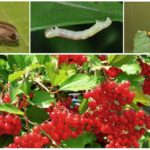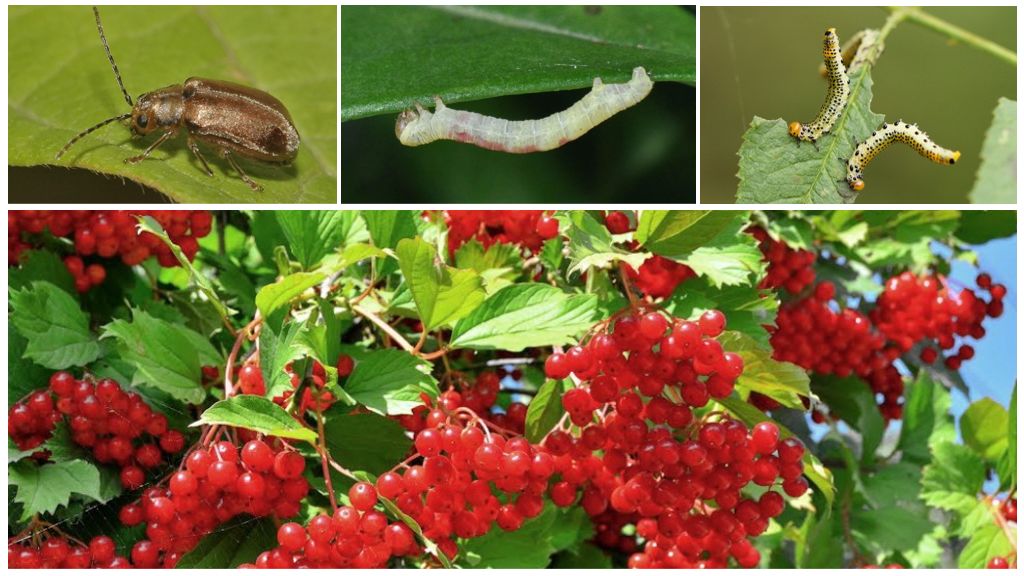How to get rid of caterpillars on Kalina
- Viburnum pests
- Folk ways of dealing with caterpillars
Kalina is a common shrub with useful fruits. During flowering viburnum bush pleases the surrounding lush snow-white buds and a pleasant aroma. Pest viburnum attracts young leaves and fruits. To save the plant, you need to know how to deal with caterpillars on Kalina and when to start measures to protect.
Viburnum pests
Viburnum bush was chosen by several species of insect pests.Their caterpillars actively eat the plant, which can even lead to its death. The most common pests include the following insects:
- Viburnum leaf beetle is a small brown beetle, about 7 mm in size. He lays laying eggs from autumn or early spring under the bark of a shrub or on the back of a leaf. In late spring, black caterpillars appear on Kalina, the beetle larvae. They have a good appetite and are able to turn the leaves of the plant into "skeletons", leaving only one of the veins. Then the caterpillars pupate and adult leaf beetles appear, which continue to feed on the remaining greens and fruits of viburnum.
- The motley moth is a green caterpillar of the same name butterfly, eats flowers of viburnum. The main activity is observed from May to July. Over the summer can two generations of butterflies appear Often there are caterpillars on Kalina Buldenezh - one of the most beautiful flowering shrubs. Destroyed inflorescences lead to crop loss.
- Honeysaws - small greenish caterpillars with bright orange head and colorful pattern on the back prefer to eat the tender foliage of viburnum.Larvae appear at the end of spring, when the shrub is covered with young greens.
Kalina eat caterpillars during the whole warm season. Optimum weather conditions and abundance of food lead to mass reproduction of pests. Larvae eat inflorescences and tender young greens. After the caterpillars on Kalina have eaten all the leaves, they pupate and turn into imago. Adult insects can eat fruits, affecting all stages of growth and development of viburnum.
Important!
A pest-damaged bush stops its growth and may not bloom next season. In advanced cases, insects destroy the plant completely. To avoid this, you need time to start fighting with the tracks on Kalina.
Methods of struggle
To get rid of the invasion of the main enemies of the bush with the help of improvised means, you should hold a number of activities:
- hold in the fall and spring inspection of the leaves of viburnum for the presence of laying eggs of leaf beetles, if they are found, cut the leaves with shears and destroy;
- To get rid of sawfly larvae that lay eggs in the upper layers of the earth, one should dig up the soil around the bush in the fall and cover it with sheets of roofing material in early spring to prevent them from appearing on the ground;
- treating viburnum stem with slaked lime or tar will not allow insects to get to the foliage from the upper soil layers;
- at the initial stage of the appearance of pests, they can be collected manually by shedding leaves with a brush or a broom.
The most effective way to save a bush is to treat viburnum from caterpillars in time. To fight use solutions of chemical preparations, plant extracts, tobacco waste, onion peel and other improvised means.
Chemicals
The use of special purchasing tools helps to quickly and effectively get rid of the tracks on the Kalina. The most popular methods using solutions are as follows:
- The first treatment of the plant occurs in the spring at the time of bud swelling. Spraying the buds and buds with a 10% solution of Karbofos (100 g of the substance per 10 liters of water) or 0.1% of Fufanon will get rid of the larvae of the moth that eat the inflorescences.
- Immediately after flowering, you can handle viburnum bush with a 0.15% solution of the Rogor preparation. This will save the foliage from the invasion of leaf beetle caterpillars.
- With a large number of pests will help spraying viburnum solution Aktara and Eleksary in a concentration of 0.08%.
Important!
When treating garden crops with chemicals, use protective gloves and a respirator. Container and sprayer should be used only for its intended purpose and stored in non-residential premises.
Shrub processing at an early stage of growth will help prevent the mass reproduction of pests and their spread throughout the plant.
Folk ways
Viburnum bush can be processed using folk remedies. They are safe for the plant, but are effective against caterpillars. During the growing season it is useful to spray viburnum branches with various infusions:
- 4 kg tomato tops in the amount of 10 liters of water and let stand for a day (you can use 1 kg of dried tops);
- 1 kg of hot pepper cut into small pieces and add a bucket of water;
- dried pharmacy chamomile infused with water in the ratio of 1 kg per 10 liters;
- 200 g of onion peel or the same amount of chopped garlic mix in a bucket of water and leave to infuse for a few hours;
- 1 kg of dried wormwood bring to a boil in a bucket of water and cool, then you can spray the leaves and inflorescences;
- 200 grams of tobacco or tobacco waste insist day in the water obtained infusion spray Kalina.
Each method can be applied at any time of the season, and even as a preventive measure you can spray healthy viburnum bushes and neighboring plants. It is recommended to process twice per season: at the end of spring and in the middle of summer. If necessary, treatment is carried out once a month. The smell of these infusions and the very content of specific products in the water will scare away any pests from the garden. Despite its effectiveness against insects, the treatment with folk remedies is safe for people, birds, and domestic animals.






 (votes: 9, Average rating: 4.67 out of 5)
(votes: 9, Average rating: 4.67 out of 5)


